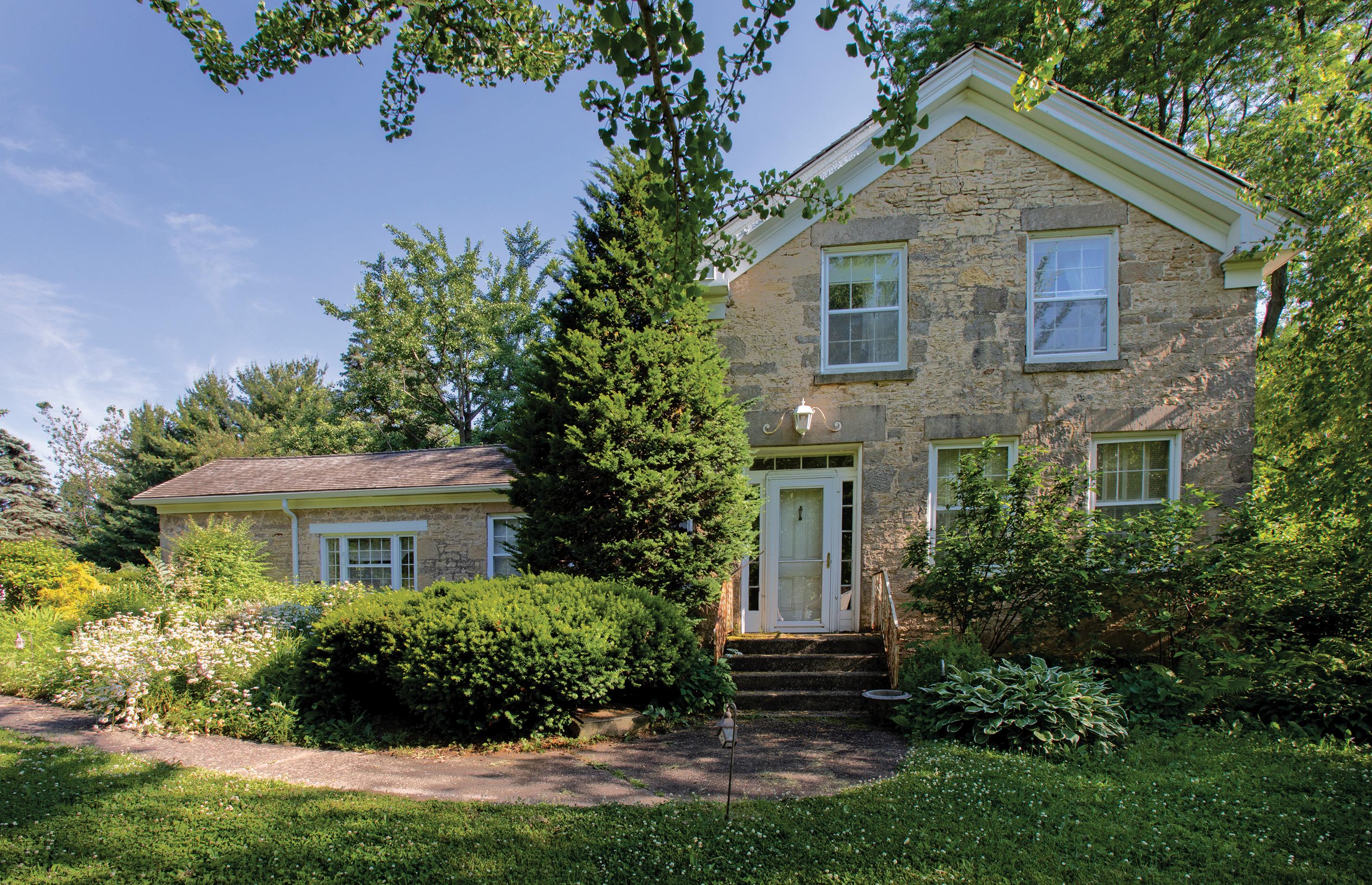
6 minute read
landmark
ALEXANDER SMITH
BY JEANNE ENGLE
Advertisement
As a young man, Alexander Smith emigrated from England (or perhaps Ireland, depending on which early census one views) in the 1800s to the township of Blooming Grove outside of Madison. There, in 1848, the same year that Wisconsin became a state and eight years before Madison was incorporated as a city, he purchased a quarter of a section (160 acres) in the northern part of the township.
Smith’s land had been previously owned by Lucius Lyon, who was contracted years before to survey what would become the Territory of Wisconsin. Lyon had bought several thousand acres in Dane County from the U.S. government.
Smith built a Greek Revival-style farmhouse on his land. Greek Revival architecture was popular from 1825 to 1860 in more-isolated parts of the country, but Smith’s farmhouse was much more than a typical farmhouse of its day. Its walls were constructed by Cornish craftsmen in the style of authentic centuries-old British tradition. Limestone from a local quarry just a short distance away was used. The house was designated a Madison landmark in November 1971.
According to the landmark nomination:
The availability of stratified quarry stone for intermediate wall construction coupled with that of larger cap stone for corner quoins [blocks] and chimney exteriors, as well as dressed stone for lintels and sills [across the tops and bottoms of
House
windows] … resulted in the most distinctive indigenous architecture to be found in the area.
At the time it was built, the Alexander Smith house was two stories tall in the shape of a Greek temple. A gable on the house at 5301 Milwaukee Street faces the street and has heavy cornices. The front of the house features an off-center main door set between sidelights with a rectangular transom above, six-over-six

wood sash windows, and a plain frieze (trim board between the top of the stone and underside of the eave).
Four rooms were downstairs and two small rooms plus a large unfinished area were upstairs. Purportedly, travelers stayed in these rooms while going between Milwaukee and Prairie du Chien. With room for a considerable number of dancers, it was also said that the large area was used as a social center for the area. The story goes that one night a brawl broke out, someone was pushed down the stairs breaking a spindle off. It’s a tale that’s been told for many years.
The big surprise about the house for Barbara Furstenberg, the current owner, is how the house was built. Barbara says, “The old style will allow the building to last for centuries, as long as proper maintenance is done. The 18-inch-thick walls were filled with rubble, allowing them to breathe. If water gets in, it can get out, and the walls dry out.” Smith added a one-story, side-gabled ell to his house in 1861 that was divided into four small rooms and a carriage house. Based on values of land and personal property listed in the 1870 census, the Smith property was worth nearly $250,000 in today’s dollars. He probably was one of the wealthier farmers in the area.
Alexander Smith’s first wife, Bridget, died in 1873. According to census records, they had four children—three boys and a girl. Smith later married Ellen Conlin in January 1878. Alexander Smith died on April 3, 1888. He left a life interest in the house and farm to his wife and only living son, George, who had been residing with them. A few years later, George probably moved out and Mrs. Smith’s brother, John Conlin, and wife, Clara, moved in. Also, half of the farm (80 acres) was sold at some point to John Sprecher. John Conlin died in 1912 and Ellen Smith in 1920. Following her death, the land and house passed to heirs of John Sprecher. After 1920, the house was unoccupied for a time, had a series of tenants, and eventually fell into disrepair. In 1946, the Alexander Smith House, also called the Stone House, was purchased by Donald S. Gray and his wife, Helen, at a sheriff’s sale. Gray had a position with the Farm Credit Administration and had appraised both urban and rural property. He was on the Board of the Dane County Historical Society. Presumably, he knew the value of the house and the property and could appreciate its specialness. Mrs. Gray was an interior designer and most likely left her mark on the inside of the house.
The Grays combined the four small rooms in the ell to create a sizable living space and installed a Lannon stone fireplace. They also put in a kitchen and mudroom in the old carriage house. One of the small rooms in the original part of the house was converted into a bathroom. The Grays did not finish the upstairs. Supposedly this was the place Mrs. Gray hung her laundry to dry.

Famous for Steaks
Home of the 20 oz. Bone-in Tenderloin

• Friday Night—Fresh Pan-fried
Lake Perch • Saturday Night—Prime Rib • Sunday—Chicken Dinner • Late Night Bar Menu & Happy Hour (Beginning at 10:00 pm) • Seasonal Outdoor Dining in our Grotto • Corral Room Available for
Private Parties
OPEN DAILY Mon-Fri Bar Opens at 4:30 pm—Dinner at 5:00 pm Weekends Open at 5:00 pm
For Reservations Call: 256-3570
Entrances at 116 S. Hamilton & 115 W. Main Street tornadosteakhouse.com


Gray was successful in getting his property and other nearby parcels annexed into Madison in 1960. Currently, the township of Blooming Grove with a few scattered neighborhoods and individual properties broken into discontinuous sections by Madison and Monona will be dissolved and totally annexed into Madison by 2027.
The second floor was finished by Della and Robert Rancourt, who purchased the house in 1973. They turned the upstairs into three rooms and installed a bathroom on that level as well. The Rancourts also put in more gardens on the property.
In 1997, Barbara and her late husband, Jim, purchased the Alexander Smith House with its two and a half acres of land. They had been living and working in Hawai‘i for nearly 30 years but wanted to move back to Madison, where they met while attending college and had friends and family.
One day while going for a walk on the east side, Jim spotted the Smith House. He thought it was perfect. An old house didn’t have problems of degassing from new carpeting, cabinets, and paint. It had desirable radiator heating. The property had gardens—he and Barbara wouldn’t have to take an elevator from their Hawai‘i high rise to get outside and enjoy them. So the Furstenbergs purchased the house and began to update it. Jim’s passion was gardening, and he put in many native plants as well as an English garden.
“It’s a comfortable house to live in,” Barbara says. “From every room, I can look outside and there are trees or flowers to look at.” Mature trees on the property include a black cherry, two ginkgos, mulberry, crab apple, and golden locusts. When the Furstenbergs moved in, there was a hedge of honeysuckles close to the house. Hedges were planted by early farmers to block the sight of the barn. The barn on this property had been replaced by a threecar garage with attached workroom.
The Alexander Smith House has stood the test of time with only five owners on its deed. During the past 70 plus years, three owners have modified the house and surrounding property to suit their particular style, always while honoring the original character of the house.
Jeanne Engle is a freelance writer.
Photographs by Eric Tadsen.

Photograph by MOD Media Productions










